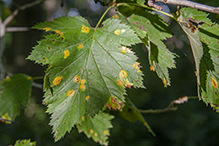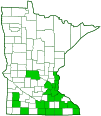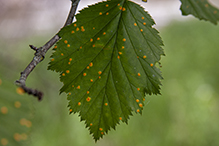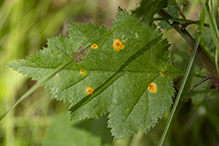Cedar-hawthorn Rust
(Gymnosporangium globosum)
Conservation • Description • Habitat • Ecology • Distribution • Taxonomy
Conservation Status |
|
|||||||
| IUCN Red List | not listed |
|||||||
| NatureServe | not listed |
|||||||
| Minnesota | not listed |
|||||||
Description |
||
On eastern redcedar, abnormal growths (galls) are formed on the stalks, twigs, and branches. They first appear in the spring. They are reddish-brown, globe-shaped, and On hawthorns, bright orangish-yellow spots appear on the leaves. They first appear in early June, and are visible on both the upper and lower leaf surfaces. In midsummer fruiting bodies (aecia) are produced on the underside of the leaf. The aecia are tube-shaped, up to ½″ long, and rusty brown. |
||
Similar Species |
||
Habitat and Hosts |
||
Evergreen hosts: Chiefly eastern redcedar; sometimes also creeping juniper and common juniper. Deciduous hosts: Most hawthorns; sometimes also serviceberry, mountain ash, apple, and crabapple. |
||
Ecology |
||
Season |
||
|
||
Life Cycle |
||
It requires two hosts and two years to complete the life cycle of this fungus. In the early spring of the first year, galls on junipers produce gelatinous cones called telial horns. These horns release spores, mostly at night and early morning, that drift with the wind. Some of these spores land on dew-moistened leaves, fresh twigs, or fruit of a deciduous host. If the landing site remains wet for 4 to 6 hours, the spores germinate and penetrate the host. After a few weeks the first visible symptoms occur on the host. About 80 to 90 days after infection, fruiting bodies, called aecia, are produced. Aecia are produced chiefly on leaves, sometimes on twigs and leaf stalks, rarely on fruit. In mid-summer to early fall the aecia split and release spores which drift in the wind. Some of these spores land on and infect an evergreen host. The fungus overwinters on the new host with no visible symptoms. In the early spring of the second year galls are formed on the evergreen host. The galls grow throughout the summer and are full size by the fall. The galls overwinter and in the early spring of the third year produce telial horns, completing the life cycle. These galls often produce spores for more than a year. |
||
Distribution |
||||
|
Sources |
|||
| 9/16/2021 | ||||
Occurrence |
||||
|
||||
Taxonomy |
|||
| Kingdom | Fungi (Fungi) | ||
| Subkingdom | Dikarya | ||
| Phylum | Basidiomycota (Basidiomycete Fungi) | ||
| Subphylum | Pucciniomycotina | ||
| Class | Pucciniomycetes | ||
Order |
Pucciniales (rust fungi) | ||
Suborder |
Uredinineae | ||
Family |
Gymnosporangiaceae | ||
Genus |
Gymnosporangium | ||
Until very recently, the genus Gymnosporangium was placed in the family Pucciniaceae. Studies showed that the genus did not belong to Pucciniaceae orto any other existing rust family. In an article published 12/31/2020, it was proposed that a new family Gymnosporangiaceae be created to accommodate the genus. At that time the order Pucciniales (rust fungi) did not have any suborders. In an article published on 7/2/2021 a framework of seven suborders was proposed containing 80% of all rust species. |
|||
Synonyms |
|||
Gymnosporangium fuscum var. globosum |
|||
Common Names |
|||
American Hawthorn Rust Cedar-hawthorn Rust Hawthorn Rust |
|||
Glossary
Gall
An abnormal growth on a plant produced in response to an insect larva, mite, bacteria, or fungus.

Slideshows |
||

Visitor Videos |
|||
Share your video of this fungus. |
|||
| This button not working for you? Simply email us at info@MinnesotaSeasons.com. Attach a video, a YouTube link, or a cloud storage link. |
|||
Other Videos |
|||

Visitor Sightings |
|||||
Report a sighting of this fungus. |
|||||
| This button not working for you? Simply email us at info@MinnesotaSeasons.com. Be sure to include a location. |
|||||
|
|
||||
MinnesotaSeasons.com Sightings |
|||||

Last Updated:



